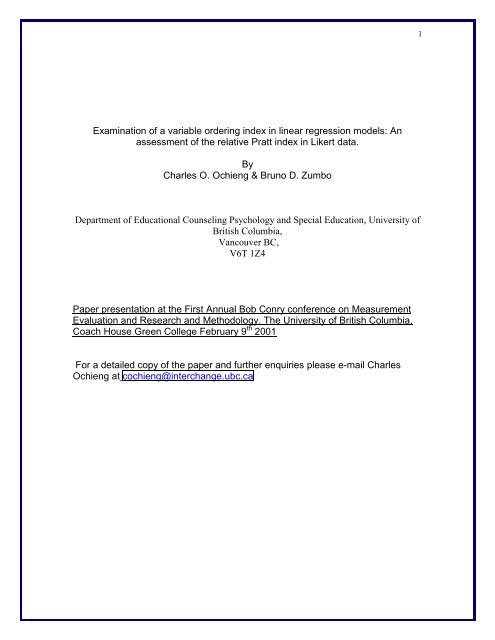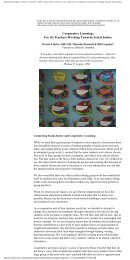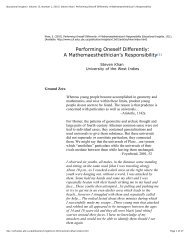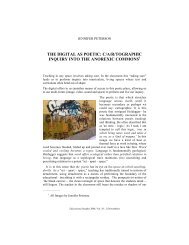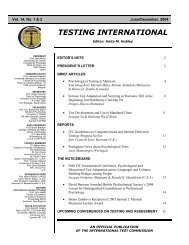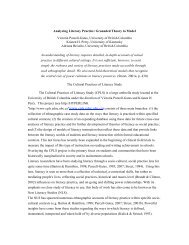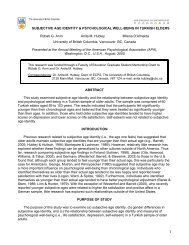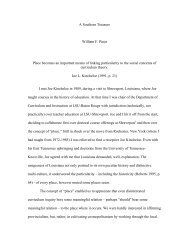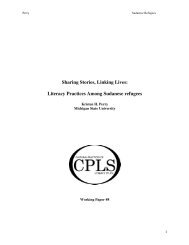Department of Educational Counseling Psychology and Special
Department of Educational Counseling Psychology and Special
Department of Educational Counseling Psychology and Special
You also want an ePaper? Increase the reach of your titles
YUMPU automatically turns print PDFs into web optimized ePapers that Google loves.
Examination <strong>of</strong> a variable ordering index in linear regression models: An<br />
assessment <strong>of</strong> the relative Pratt index in Likert data.<br />
By<br />
Charles O. Ochieng & Bruno D. Zumbo<br />
<strong>Department</strong> <strong>of</strong> <strong>Educational</strong> <strong>Counseling</strong> <strong>Psychology</strong> <strong>and</strong> <strong>Special</strong> Education, University <strong>of</strong><br />
British Columbia,<br />
Vancouver BC,<br />
V6T 1Z4<br />
Paper presentation at the First Annual Bob Conry conference on Measurement<br />
Evaluation <strong>and</strong> Research <strong>and</strong> Methodology. The University <strong>of</strong> British Columbia,<br />
Coach House Green College February 9 th 2001<br />
For a detailed copy <strong>of</strong> the paper <strong>and</strong> further enquiries please e-mail Charles<br />
Ochieng at cochieng@interchange.ubc.ca<br />
1
Outline <strong>of</strong> the study<br />
Background to the problem<br />
Description <strong>of</strong> relative Pratt index<br />
Rationale <strong>of</strong> the study<br />
Research question<br />
Method<br />
Results<br />
Conclusion<br />
Implications for research<br />
Background to the problem<br />
Often, researchers are concerned by significance <strong>and</strong> relative importance <strong>of</strong><br />
variables in linear regression models for meaningful interpretation <strong>of</strong> results.<br />
Several indices have been proposed in determining relative importance <strong>of</strong><br />
predictor variables in regression models among which are relative Pratt index,<br />
Beta coefficients β, t-values, commonality components, semi-partial correlation<br />
srj <strong>and</strong> partial correlation prj. Selection <strong>and</strong> ordering <strong>of</strong> variables in a<br />
regression model are therefore dependent on the relative importance <strong>of</strong> the<br />
variable compared to the others.<br />
Relative importance <strong>of</strong> variable Xj in a regression equation is determined by<br />
the proportion <strong>of</strong> the variance in the criterion variable Y accounted for by Xj<br />
(Kruskall, 1987; Pratt, 1987; Bring, 1994, 1996; Thomas, Hughes, & Zumbo,<br />
1998) where Xj is a predictor variable in the regression model. Pedhazur<br />
(1982) <strong>and</strong> Darlington (1990) suggest that beta weights <strong>and</strong> partial correlations<br />
should not be used in determining relative importance due to luck <strong>of</strong><br />
proportionality <strong>and</strong> additive properties in relation to the variance in the criterion<br />
variable, instead semi-partial correlations may be used.<br />
Because <strong>of</strong> its additive property <strong>and</strong> simplicity in interpretation, the relative<br />
Pratt index has an advantage over the semi-partial correlation <strong>and</strong> lends itself<br />
as the most promising <strong>and</strong> prudent index to use in determining relative<br />
importance <strong>and</strong> ordering <strong>of</strong> variables (Huberty, 1994; Thomas & Zumbo, 1996;<br />
Thomas, Hughes, & Zumbo, 1998).<br />
Description <strong>of</strong> the relative Pratt index<br />
Relative Pratt index is a geometric extension based on the axiomatic<br />
derivation in the 2-variable case (Pratt, 1987) <strong>of</strong> the product <strong>of</strong> the simple<br />
correlation <strong>and</strong> beta coefficient <strong>of</strong> a variable Xj from the st<strong>and</strong>ardized<br />
regression equation <strong>of</strong> the form:<br />
Y = β1X1 +β2X2+…βjXj +βpXp.<br />
2
The relative Pratt index dj (Thomas, Hughes & Zumbo, 1998) is then computed<br />
as follows;<br />
dj = βjrj/R 2 .<br />
The resulting quotient dj is the proportion <strong>of</strong> variance R 2 in the criterion<br />
variable accounted for by the predictor variable Xj. Thus, the Pratt index is<br />
used in the variance partitioning <strong>of</strong> R 2 for each predictor. For a regression<br />
model the sum <strong>of</strong> the relative Pratt index <strong>of</strong> the predictors add up to one.<br />
Relative Pratt index can be used together with beta weights to identify any<br />
suppressor variables that may be present in a regression equation (see<br />
Thomas, Hughes, & Zumbo, 1998). This is derived from negative valued Pratt<br />
index. Only relative Pratt index <strong>of</strong> the value dj > 1/2p where p is the number<br />
<strong>of</strong> predictors in the regression equation, have meaningful relative importance<br />
<strong>and</strong> is usually interpreted.<br />
Rationale <strong>of</strong> the study<br />
While relative Pratt index has been endorsed as an appropriate measure <strong>of</strong><br />
relative importance <strong>of</strong> predictor variables in linear regression models, little is<br />
known <strong>of</strong> the effect <strong>of</strong> Likert data on its accuracy <strong>and</strong> performance under<br />
different conditions <strong>of</strong> Likert scales <strong>and</strong> response distribution.<br />
Research question<br />
The basic assumption in linear regression models is that predictors <strong>and</strong> criterion<br />
variable s are continuous <strong>and</strong> normally distributed. This may not be the case in<br />
real data encountered in practice in social science research. Research questions<br />
are as follows;<br />
• How stable are Pratt indices under non-continuous <strong>and</strong> non-normal<br />
conditions?<br />
• What are the effects <strong>of</strong> (1) distribution <strong>of</strong> response patterns, (2) correlation<br />
matrices, (3) variable combination <strong>of</strong> continuous <strong>and</strong> Likert data <strong>and</strong> (4)<br />
number <strong>of</strong> Likert scale points, on the accuracy <strong>and</strong> consistency <strong>of</strong> relative<br />
Pratt index?<br />
• To answer the research questions, the following method was used.<br />
Method<br />
Simulated data was used in the study. Because the study sort to determine<br />
the accuracy (bias) <strong>of</strong> relative Pratt index under the stated conditions, a<br />
population <strong>of</strong> 500 000 was generated using three correlation matrices depicting<br />
low moderate <strong>and</strong> high inter-item correlation among predictors <strong>and</strong> criterion for<br />
each condition (Stevens, 1986). Three types <strong>of</strong> response distributions were<br />
simulated namely, (1) equal interval symmetric distribution (2) unequal interval<br />
<strong>and</strong> threshold, positively skewed distribution (3) unequal interval <strong>and</strong> threshold,<br />
negatively skewed distribution.<br />
For variable combination <strong>of</strong> continuous <strong>and</strong> Likert data, three types <strong>of</strong> data<br />
condition <strong>of</strong> X <strong>and</strong> Y were simulated namely, (1) Y Likert, <strong>and</strong> X continuous (2) Y<br />
continuous <strong>and</strong> X Likert (3) Y Likert <strong>and</strong> X Likert. For each <strong>of</strong> the three<br />
conditions, eight Likert scale categories ranging from 2-scale points to 9-scale<br />
points were generated. The study was a 3x3x3x8 factorial design.<br />
3
A linear regression model was then fit for each condition using three<br />
predictors X1, X2, <strong>and</strong> X3. The resulting R 2 <strong>and</strong> relative Pratt indices associated<br />
with each predictor were computed <strong>and</strong> compared to those <strong>of</strong> the baseline<br />
condition with Y continuous <strong>and</strong> X continuous, <strong>and</strong> equal interval as well as<br />
normal distribution.<br />
Bias in Pratt index was computed as follows;<br />
Pratt Bias∆ = Pratt model – Pratt cont<br />
Percent bias was also computed as follows:<br />
Percent bias = Pratt bias/ Pratt cont x 100.<br />
Percent bias was used as a unit <strong>of</strong><br />
Analysis.<br />
Results<br />
1. Graphs were plotted for the percent bias against the number <strong>of</strong> Likert<br />
scale point categories for each variable combination <strong>and</strong> type <strong>of</strong><br />
response pattern within each condition <strong>of</strong> correlation matrix.<br />
2. To provide further insight on the effects <strong>of</strong> the four independent<br />
variables on percent bias <strong>of</strong> relative Pratt index, a response surface<br />
model was fit using the response surface methodology (Box & Draper<br />
1987;Khuri & Cornell, 1987; Zumbo & Harwell, 1999)<br />
Findings<br />
From the response surface model, within low <strong>and</strong> moderate matrices there<br />
were significant main effects for category at variable combination 2 (Y<br />
continuous, X Likert) <strong>and</strong> significant main effects for response pattern at<br />
variable combination 3 (Y Likert <strong>and</strong> X Likert). However, for high correlation<br />
matrix there were significant main effects for categories in the three variable<br />
combinations. While there were significant differences in percent bias between<br />
categories <strong>of</strong> Likert scales, the order <strong>of</strong> the variables remained unchanged<br />
across the independent variables. Percent bias diminished with increase in<br />
scale points from 2-point Likert scale <strong>and</strong> leveled <strong>of</strong>f asymptotically at 4-point<br />
Likert scale.<br />
Conclusion<br />
Relative Pratt index remains relatively robust in terms <strong>of</strong> variable ordering <strong>of</strong><br />
relative importance under the stated conditions <strong>of</strong> types correlation matrix, type<br />
<strong>of</strong> response pattern distribution, number <strong>of</strong> Likert scale points <strong>and</strong> variable<br />
combination <strong>of</strong> continuous <strong>and</strong> Likert data. Percent bias was relatively large at<br />
the 2-point scale in all the three response patterns for equal <strong>and</strong> unequal<br />
thresholds <strong>and</strong> intervals.<br />
While bias occurred at each Likert scale point, relative ordering <strong>of</strong> the variables<br />
was not affected. Thus, Likert scaling does not impact the ordering <strong>of</strong> variables<br />
<strong>and</strong> therefore relative importance, as measured by relative Pratt index.<br />
Bias in relative Pratt index reduced with increase in Likert scale points, but<br />
remained almost constant after the 4-point Likert scale.<br />
4
Implication for research<br />
Researchers may opt for relative Pratt index due to its additive properties in<br />
variance partitioning, ease <strong>of</strong> interpretation, low bias in 4-point Likert scales or<br />
higher, <strong>and</strong> consistency across Likert scales that are frequently encountered in<br />
social science research.<br />
Due to its additive property in the variance partition <strong>of</strong> the criterion variable,<br />
relative Pratt index may now replace or supplement other measures <strong>of</strong> relative<br />
importance such as communality analysis measures that are cumbersome in<br />
terms <strong>of</strong> meaningful interpretation. This is clearly evident with more predictors<br />
in the model. Relative Pratt index may also be used together with st<strong>and</strong>ardized<br />
regression weights to identify any suppressor variables <strong>and</strong> multicollinearity<br />
cases that may be present in the regression model. This is inferred from<br />
negative values that may occur in the computation <strong>of</strong> Pratt index. The<br />
suppressor variables can then be analyzed separately.<br />
References:<br />
Box, G.E. P., & Draper, N. R. (1987). Empirical model-building <strong>and</strong><br />
response surfaces. New York: John Wiley & Sons, Inc..<br />
Bring, J. (1994). How to st<strong>and</strong>ardize regression coefficients. The<br />
American Statistician, 48, 209-213.<br />
Bring, J. (1996). A geometric approach to compare variables in a<br />
regresion model. The American Statistician, 50, 57-62.<br />
Darlington, R. B. (1990). Regression <strong>and</strong> linear models. New York:<br />
McGraw-Hill.<br />
Khuri, A. I., Cornell, J.A. (1987). Response surfaces: Designs <strong>and</strong><br />
analyses. New York: Marcel Dekker, Inc..<br />
Kruskal, W. (1987). Relative importance by averaging over orderings.<br />
American Statistician, 41, 6-10.<br />
Pedhazur, E. J. (1982). Multiple Regression in Behavioural Research (2nd<br />
ed.), New York: Holt, Reinhart & Winston.<br />
Pratt, J.W. (1987). Dividing the indivisible: using simple symmetry to<br />
partition variance explained," In T. Pukkila an S. Puntanen (Eds.), Proceedings <strong>of</strong><br />
the Second International Conference in Statistics, (pp. 245-260). Tampere,<br />
Findl<strong>and</strong>: University <strong>of</strong> Tampere.<br />
Stevens,J. ( 1986). Applied multivariate statistics for the social sciences.<br />
Hillsdale, New Jersey.Lawrence Erlbaum Associates, Publishers.<br />
Thomas, D. R., Hughes, E., & Zumbo, B. D. (1998). On variable<br />
importance in linear regression. Social Indicators Research: An International <strong>and</strong><br />
Interdisciplinary Journal for Quality-<strong>of</strong>-Life Measurement, 45, 253-275.<br />
Thomas, D. R., & Zumbo, B. D. (1996). Using a measure <strong>of</strong> variable<br />
importance to investigate the st<strong>and</strong>ardization <strong>of</strong> discriminant coefficients. Journal<br />
<strong>of</strong> <strong>Educational</strong> & Behavioral Statistics, 21, 110-130.<br />
Zumbo, B. D., & Harwell, M. R. (1999). The methodology <strong>of</strong><br />
methodological research: Analyzing the results <strong>of</strong> simulation experiments. (Paper<br />
No. ESQBS-99-2). Prince George, B. C.: University <strong>of</strong> Northern British Columbia.<br />
Edgeworth Laboratory for Quantitative Behavioral Science.<br />
5


